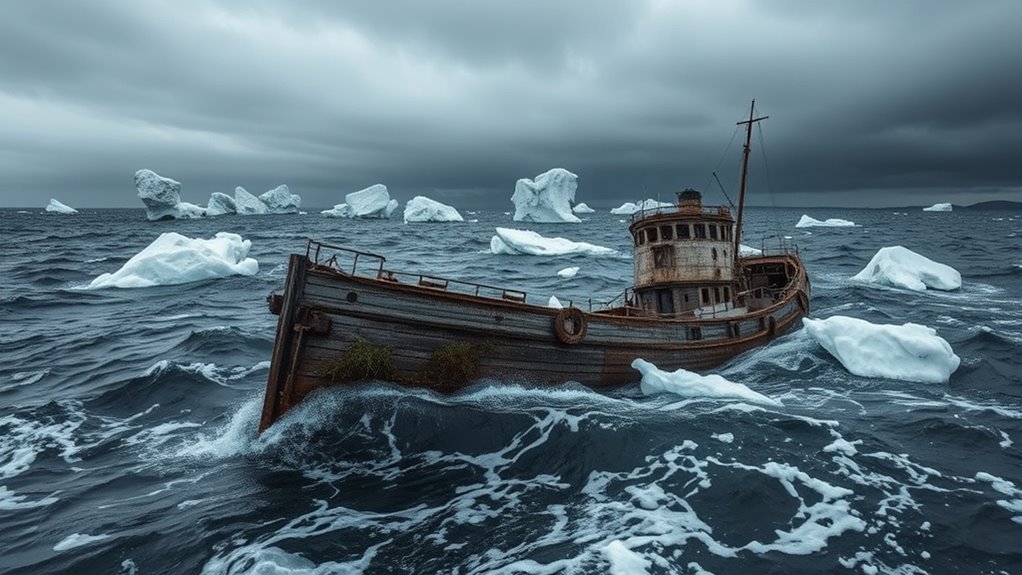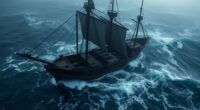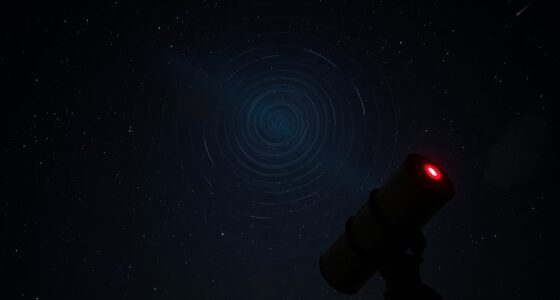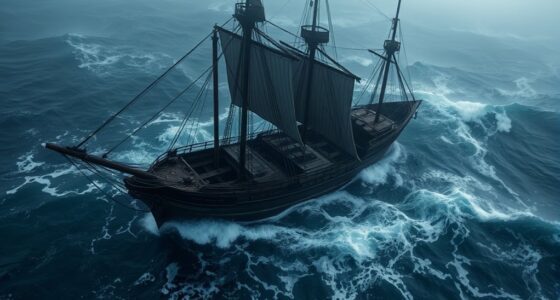Forensic oceanography has shed new light on the Mary Celeste mystery by analyzing ocean currents, weather patterns, and debris distribution. These scientific insights suggest natural causes like sudden storms and turbulent seas, rather than foul play, led to the ship’s abrupt abandonment. By reconstructing the ship’s final moments with precise data, experts now believe the disaster was a natural event. Keep exploring to discover how this innovative approach unravels centuries-old maritime enigmas.
Key Takeaways
- Forensic oceanography uses scientific methods to analyze weather, currents, and debris to reconstruct the Mary Celeste’s final moments.
- Simulations suggest natural factors like storms and turbulent seas caused sudden chaos, leading to the ship’s abandonment.
- Evidence indicates the crew likely abandoned ship temporarily due to emergency, rather than foul play or piracy.
- Oceanographic analysis clarifies the ship’s disappearance, blending scientific data with historical records to solve the mystery.
- Insights from forensic oceanography have improved maritime safety standards by understanding natural hazards at sea.
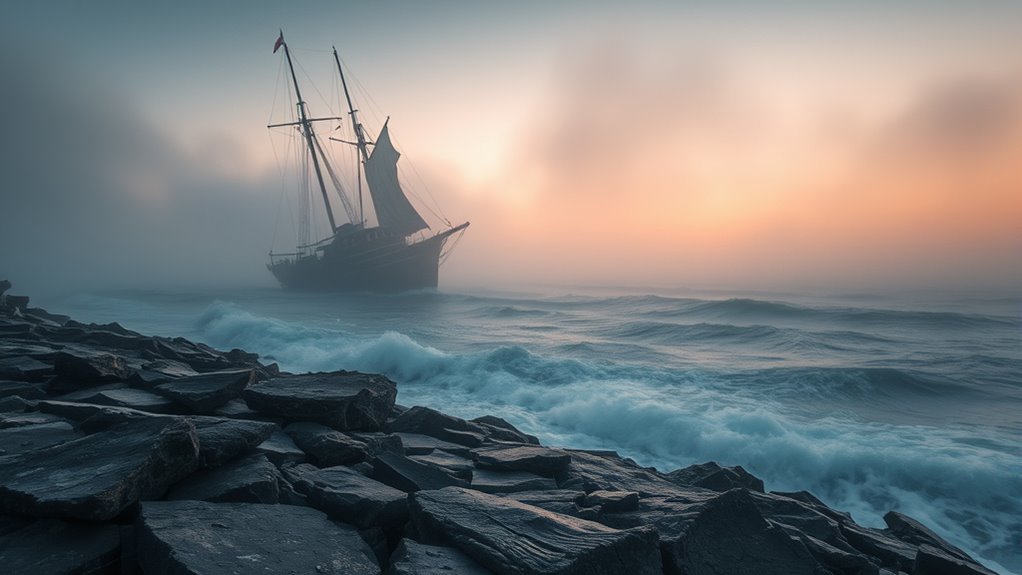
Have you ever wondered what happened to the crew of the Mary Celeste? This enduring question has captivated sailors, historians, and mystery enthusiasts alike for over a century. As one of the most famous sailing legends, the ship’s disappearance remains a haunting reminder of the perils of maritime travel. The story’s intrigue is rooted not only in the unanswered questions but also in how it challenged and shaped maritime safety standards. Over the years, countless theories emerged—from pirates and mutiny to supernatural forces—each adding layers to the legend. Yet, despite these tales, no definitive explanation existed, leaving the mystery open and fueling speculation.
The mystery of the Mary Celeste endures, inspiring theories and shaping maritime safety standards for over a century.
Recently, advances in forensic oceanography have offered new insights into what might have truly happened aboard the Mary Celeste. Forensic oceanography combines ocean science, forensic analysis, and historical research to reconstruct past maritime events with scientific precision. By examining weather patterns, ocean currents, and debris distribution, experts can simulate what conditions the ship faced. This approach allows us to piece together a more accurate timeline of the voyage and the ship’s sudden abandonment. It’s a groundbreaking method that’s transforming how we understand maritime mysteries, shedding light on the dangers faced by sailors and the importance of maritime safety.
Using these techniques, researchers have found that a combination of natural factors could explain the ship’s mysterious abandonment. Strong winds and turbulent seas may have created chaos on board, prompting the crew to abandon ship temporarily. Simulation models suggest that the ship could have been driven off course by unexpected storms, while floating debris and the ship’s condition support the idea of a sudden emergency rather than foul play. By analyzing the currents, scientists can trace the dispersal of objects and wreckage, helping to reconstruct the ship’s final moments. This scientific approach bridges the gap between legend and reality, providing a logical explanation that aligns with the evidence. Additionally, understanding the support hours of maritime support services can help prevent similar incidents through timely assistance and safety protocols.
What this means for maritime safety is significant. The Mary Celeste’s story highlights the importance of understanding natural hazards and preparing for the unpredictable nature of the sea. Modern navigation tools, safety protocols, and weather forecasting are direct responses to lessons learned from such mysteries. For you, as someone interested in maritime history or sailing, these insights underscore why safety measures are vital when venturing into open waters. The forensic approach doesn’t just solve historical puzzles; it also helps improve current safety standards, reducing the likelihood of similar incidents. Ultimately, this fusion of science and history keeps the legend alive while advancing our knowledge — turning a centuries-old mystery into a lesson for future mariners.
Frequently Asked Questions
What Was the Original Cargo of the Mary Celeste?
You ask about the original cargo contents of the Mary Celeste. You discover it carried mostly alcohol, specifically barrels of denatured alcohol, along with ship’s supplies like food and water. The cargo contents were intended for trade, but the ship was found abandoned, leading to mystery. Forensic oceanography helps uncover clues about what happened, but the cargo itself was primarily alcohol, which could have influenced the ship’s fate.
Were There Any Signs of a Struggle Onboard?
You notice no clear signs of a struggle onboard the Mary Celeste, but ghost footprints suggest someone moved around hurriedly. Missing personal items hint at a sudden departure or disturbance. These clues imply that the crew might have left unexpectedly, possibly due to an emergency or unknown threat. While no direct evidence confirms a fight, these subtle signs raise questions about what caused the crew’s abrupt disappearance.
How Did Weather Conditions Contribute to the Mystery?
You might wonder how weather conditions contributed to the mystery. By analyzing shipwreck patterns and ocean current analysis, you see that rough weather could have caused the crew to abandon ship suddenly, without signs of struggle. Strong currents might have carried the vessel away or hidden clues, making it harder to determine what happened. These factors help explain the ship’s sudden disappearance, emphasizing nature’s powerful role in maritime mysteries.
Were Any Crew Members Ever Found or Identified?
Did you know that none of the crew members from the Mary Celeste were ever found or identified? Despite extensive searches, all crew members remain missing, fueling the mystery. The focus on crew survival highlights the strange circumstances, as no bodies or personal belongings linked to missing persons have ever surfaced. This unresolved fate keeps the story intriguing, leaving us to wonder what truly happened aboard the ship.
What Modern Forensic Techniques Were Used to Analyze the Case?
You’d find that modern forensic techniques like sea surface analysis and forensic imaging played key roles in examining the case. Sea surface analysis helps detect unusual patterns or disturbances on the water’s surface, indicating potential events. Forensic imaging allows detailed examination of shipwrecks and debris, revealing clues about what happened. These tools help piece together the mystery, providing insights that would’ve been impossible with traditional methods alone.
Conclusion
As you now see, the Mary Celeste’s story is like a ship adrift in a foggy sea, where every wave whispers a clue. Forensic oceanography acts as your lighthouse, piercing the darkness and guiding you to the truth behind the mystery. Just as a lighthouse reveals the safe path, science reveals the secrets hidden beneath the waves. With this newfound clarity, you can finally navigate the true story behind the ghostly vessel.
